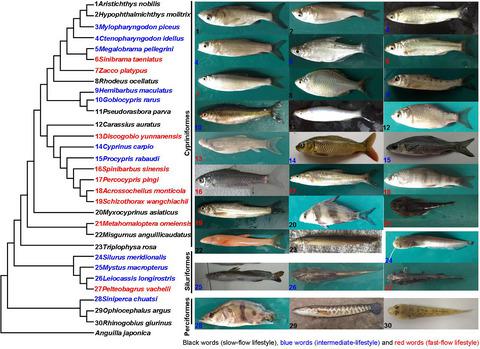当前位置:
X-MOL 学术
›
Funct. Ecol.
›
论文详情
Our official English website, www.x-mol.net, welcomes your feedback! (Note: you will need to create a separate account there.)
Interspecific differences and ecological correlations of energy metabolism traits in freshwater fishes
Functional Ecology ( IF 5.2 ) Pub Date : 2019-12-27 , DOI: 10.1111/1365-2435.13505 Xu Pang 1, 2 , Feng Shao 1 , Shi‐Huan Ding 1, 2 , Shi‐Jian Fu 3 , Yao‐Guang Zhang 1
Functional Ecology ( IF 5.2 ) Pub Date : 2019-12-27 , DOI: 10.1111/1365-2435.13505 Xu Pang 1, 2 , Feng Shao 1 , Shi‐Huan Ding 1, 2 , Shi‐Jian Fu 3 , Yao‐Guang Zhang 1
Affiliation

|
Metabolic energy fuels all biological processes, and thus, energy metabolism is vitally important for organisms. It has been suggested that interspecific variation in physiological functions is associated with the energetic metabolism of organisms, which varies considerably due to selection, adaptation and evolution. Thus, the present study aimed to clarify the relationship between the interspecific diversification of maintenance energy expenditure and two forms of anaerobic capacity (in terms of exercise and hypoxia tolerance) in freshwater fishes. Moreover, in the context of environmental adaptation, we hypothesized that selection for increased locomotor performance in species with a fast‐flow lifestyle favours a high aerobic and anaerobic capacity and, consequently, a high maintenance metabolism, whereas selection for strong hypoxia tolerance in species with a slow‐flow lifestyle favours a reduced maintenance metabolism and a reduced aerobic capacity. We examined these topics among 30 species of freshwater fish with different lifestyles based on the flow regimes of their habitats (fast, intermediate and slow flow). The resting metabolic rate of each species was measured, and then, the fish were subjected to two treatments: (a) exercise to exhaustion, after which we measured the maximum metabolic rate, excess post‐exercise oxygen consumption and metabolic recovery rate; and (b) hypoxia to the point of loss of equilibrium (LOE), after which we measured the metabolic response to recovery from hypoxia, including the peak metabolic rate (PMRₕ) and the excess post‐hypoxia oxygen consumption (EPOCₕ). We found that the resting metabolic rate was positively correlated with both the aerobic and anaerobic capacity of the fishes and that species from fast‐flow habitats have higher aerobic and anaerobic capacity with concomitantly increased resting metabolism. However, neither EPOCₕ nor LOE was correlated with resting metabolic rate. In summary, we suggest that selection for increased aerobic and anaerobic capacity to facilitate the demands of exercise has occurred in fast‐flow species, that selection for hypoxia tolerance may have favoured a reduction in this capacity in intermediate and slow‐flow species, and that specialized adaptations (such as flexibility in gill morphology and altered metabolic pathways) play important roles in hypoxia tolerance in some species. A free Plain Language Summary can be found within the Supporting Information of this article.
中文翻译:

淡水鱼类能量代谢性状的种间差异及生态相关性
代谢能为所有生物过程提供燃料,因此,能量代谢对生物体至关重要。有人提出,生理功能的种间变异与生物体的能量代谢有关,由于选择、适应和进化而变化很大。因此,本研究旨在阐明淡水鱼维持能量消耗的种间多样化与两种形式的无氧能力(在运动和缺氧耐受方面)之间的关系。此外,在环境适应的背景下,我们假设在快节奏生活方式的物种中选择提高运动能力有利于高有氧和无氧能力,因此,高维持代谢,而在慢流生活方式的物种中选择强缺氧耐受性有利于降低维持代谢和降低有氧能力。我们根据栖息地的水流状况(快流、中流和慢流)对 30 种不同生活方式的淡水鱼进行了研究。测量每个物种的静息代谢率,然后对鱼进行两种处理:(a) 运动至力竭,之后我们测量最大代谢率、运动后过量耗氧量和代谢恢复率;(b) 缺氧到失去平衡点 (LOE),之后我们测量了从缺氧中恢复的代谢反应,包括峰值代谢率 (PMRₕ) 和缺氧后过度耗氧量 (EPOCₕ)。我们发现静息代谢率与鱼类的有氧和厌氧能力呈正相关,并且来自快流栖息地的物种具有更高的有氧和厌氧能力,同时静息代谢增加。然而,EPOCₕ 和 LOE 均与静息代谢率无关。总而言之,我们建议在快流物种中选择增加有氧和无氧能力以促进运动需求,对缺氧耐受性的选择可能有利于中速和慢流物种的这种能力降低,并且特殊的适应性(例如鳃形态的灵活性和代谢途径的改变)在某些物种的缺氧耐受性中起着重要作用。
更新日期:2019-12-27
中文翻译:

淡水鱼类能量代谢性状的种间差异及生态相关性
代谢能为所有生物过程提供燃料,因此,能量代谢对生物体至关重要。有人提出,生理功能的种间变异与生物体的能量代谢有关,由于选择、适应和进化而变化很大。因此,本研究旨在阐明淡水鱼维持能量消耗的种间多样化与两种形式的无氧能力(在运动和缺氧耐受方面)之间的关系。此外,在环境适应的背景下,我们假设在快节奏生活方式的物种中选择提高运动能力有利于高有氧和无氧能力,因此,高维持代谢,而在慢流生活方式的物种中选择强缺氧耐受性有利于降低维持代谢和降低有氧能力。我们根据栖息地的水流状况(快流、中流和慢流)对 30 种不同生活方式的淡水鱼进行了研究。测量每个物种的静息代谢率,然后对鱼进行两种处理:(a) 运动至力竭,之后我们测量最大代谢率、运动后过量耗氧量和代谢恢复率;(b) 缺氧到失去平衡点 (LOE),之后我们测量了从缺氧中恢复的代谢反应,包括峰值代谢率 (PMRₕ) 和缺氧后过度耗氧量 (EPOCₕ)。我们发现静息代谢率与鱼类的有氧和厌氧能力呈正相关,并且来自快流栖息地的物种具有更高的有氧和厌氧能力,同时静息代谢增加。然而,EPOCₕ 和 LOE 均与静息代谢率无关。总而言之,我们建议在快流物种中选择增加有氧和无氧能力以促进运动需求,对缺氧耐受性的选择可能有利于中速和慢流物种的这种能力降低,并且特殊的适应性(例如鳃形态的灵活性和代谢途径的改变)在某些物种的缺氧耐受性中起着重要作用。



























 京公网安备 11010802027423号
京公网安备 11010802027423号